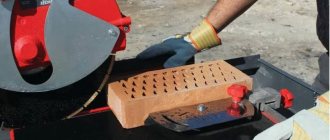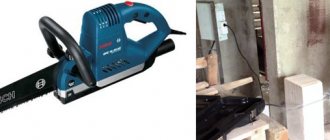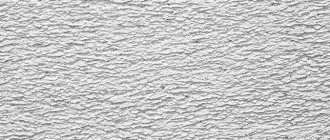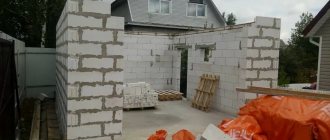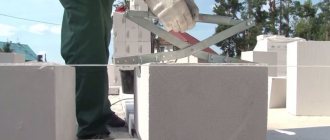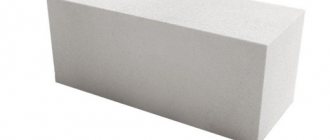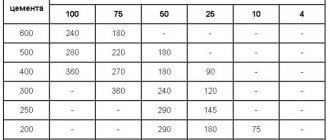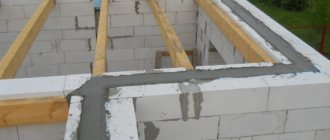One of the advantages of wall blocks made of lightweight cellular concrete is the ease of processing - cutting into elements of the desired size and shape. Having already built several houses from this material, I can say that it is not as easy as described. In any case, this procedure takes a lot of time and effort, especially if the project includes such non-standard elements as projections, niches, and bay windows. Now, when choosing what to cut aerated concrete blocks with, I focus on the volume and complexity of the work ahead.
Source infradom.ru
Hand saw
This saw is used in the construction of small objects (country house, outbuilding, garage, etc.), where it is not necessary to saw a large number of foam blocks.
However, it is worth thinking about what to cut; if the density of the foam blocks is high, then it is better, of course, to use an electric tool.
Don’t be afraid of a hand saw; if you work carefully and carefully, you can cut without unevenness or chips, and you can also cut out shaped elements.
However, you need to remember that foam blocks are a special building material; you need to work with it carefully. When sawing, it tends to crumble! No need to put pressure on the tool! Only completely dry material can be cut with a hand saw.
Sawing, as a rule, is better and easier according to pre-made marks. The position of the saw should be at an angle of 45 degrees. The saw must be long so that at the finish line the unfinished residue does not break off and fall off, ruining the cut.
Professional tools
How to cut foam blocks or gas silicate blocks if you have to build a large two-story house with a large number of corners, openings and architectural protrusions is a pressing question. A regular straight cut of one block takes about 5 minutes with a hand saw, and 2-3 minutes with a reciprocating saw. It doesn’t seem like much, but considering the number and complexity of the cuts, the loss of time is very noticeable. Therefore, for large volumes of work, it is advisable to acquire a professional tool - a special machine or an “alligator” saw.
Purchasing machine tools for a private developer is overkill and too expensive. But the Alligator saw will be an excellent helper. Its cutting tool is two blades moving towards each other.
Source torriacars.sk
The tool has one drawback - its rather high price. But if you take into account its share in the total cost of wall blocks, it no longer seems so large. Especially if you count how many hand saws or saw blades you will have to change during your work, and how much time you can save.
The alligator allows you to significantly increase the speed and accuracy of masonry, since you can saw aerated concrete blocks even after they have been laid in the wall. The part of the block protruding beyond the corner or into the opening is cut off using the plane of the upper block as a stop.
The capabilities of this tool are shown in the video:
In principle, you can cut a block of cellular concrete with a regular chain saw, but it will not withstand long-term and active use for other purposes:
- the chain will quickly become dull (which is partially solved by using an expensive chain with pobedite soldering);
- during continuous operation, it will heat up and stretch (to prevent this, the instrument must be given rest breaks);
- the sprockets will quickly wear down due to working in a hard environment;
- the motor may fail due to strong dust formation, which is accompanied by cutting foam and gas blocks.
Alligators also have dust protection.
Electric jigsaw
Craftsmen know this type of jigsaw as a reciprocating saw. This saw is used in the construction of medium and large objects.
You can change the blades on a jigsaw (put discs with different tooth sizes, change dull or damaged discs; the shape of the teeth on the discs can also be different - large and small teeth).
As a rule, for the convenience of builders, many saw models are available with replaceable batteries so as not to be tied to a power source.
When working with this type of tool, you must remember that sawing wet material is not permissible, as this may result in injury. The saw will “chew” the crumbs and may injure the builder.
Before starting work, it is better to try on the tool. Play through the saw movements without the power on.
You need to cut with the middle part of the saw; the length of the working cutting surface should be approximately 25 centimeters.
To avoid injury, you should hold the saw firmly in your hands.
Briefly about the main thing
As you can see, there is plenty to choose from when cutting foam blocks. The most affordable option is a hand saw for cellular concrete, but it must be of good quality. A reciprocating saw with special blades will save a lot of time. And for large volumes and complex work there is nothing better than an Alligator saw. To make your choice, consider whether it is worth spending money on an expensive power tool and whether it will be useful to you in the future.
Question
Write in the comments if you don’t have the right tool, would you prefer to save money and buy a handsaw or would you sacrifice a decent amount for the quality and speed of work?
Alligator
The alligator-type saw is particularly durable and wear-resistant. The teeth of such a saw have special coatings made of pobedite, which makes the teeth more durable. This tool is used in the construction of large objects (apartment buildings, large offices).
The advantage of this tool is that it does not need to be constantly sharpened or blades changed, as, for example, in an electric jigsaw.
When purchasing such a saw, it is better to choose an option with a thick-walled blade, since only cutting with such a blade will give an even cut without chips or roughness.
It is often written that before starting to work with such a saw, you need to lubricate the surface with a special lubricant, but practice says otherwise. The lubricant mixes with dust, causing the saw to stop working.
Although the instructions for most tools of this type specify the use of lubricant. The absence of lubricant increases productivity significantly.
Cutting Notches
To install jumpers or fill an armored belt, you need special U-blocks with a recess-trough into which reinforcement is installed and concrete is poured. It is better to buy them ready-made. But it happens that it was not available or there was not enough, and you have to think about how to cut the gas block to obtain such a complex shape.
All of the tools listed can be used, but with their help it is difficult to achieve the same depth of the slots and an even line of their “bottom”. In such cases, I recommend a circular or circular saw, the blade of which can be set to the desired height. If you have a wall chaser, even better.
How to make a block with a recess yourself, watch the video:
Household saw on chain
Some home craftsmen saw foam blocks with a regular saw, which is used to saw wood. This method is fast and quite effective, but the chains quickly become dull, and sometimes even break and jam.
In addition, when cutting with such a saw, a very large amount of harmful dust is generated. Therefore, if you plan to saw in this way, be sure to protect your respiratory organs from dust.
When choosing a tool for cutting aerated concrete, there is no need to chase cheapness. As a rule, cheap does not mean reliable. However, it is better not to rely on your intuition, especially if you have no experience in this matter, but to read reviews or talk with knowledgeable people.
Usually people without experience who want to build a small object for themselves opt for hand tools. Firstly, it is cheaper, and secondly, it is easier to work with. People with experience prefer a more complex tool - an electric one.
Tools for small jobs
Aerated concrete can be sawed with both hand and electric tools. It doesn’t make sense to specifically purchase an expensive electric one for building one small house or garage of a simple rectangular shape - you can get by with a hand saw designed specifically for this purpose. But if you have a reciprocating saw, things will go faster. Both tools easily cope with simple vertical cutting of blocks when you need to cut off a part from it.
Hand saw for aerated concrete
Manufacturers of hand tools have long thought about how to cut aerated concrete blocks and have launched the production of special hacksaws. They are sold separately or as part of a set of tools for laying blocks, which also includes a trowel, a ladle and a carriage for glue, a wall chaser, a scraper, and a square.
Source buildhouse.rf
When choosing such a hacksaw, pay attention not so much to the brand, but to the presence of pobedite soldering on the teeth, the thickness and hardness of the blade. If it is “liquid” and bends easily, the blade will move to the side and the cut will not be accurate. And soldering will extend the life of the tool; you won’t have to sharpen it or buy a new one to replace a dull one.
It is important! It is very difficult to cut blocks that have not dried well or have become wet in the rain - the hacksaw will get stuck in them. Therefore, before sawing aerated concrete, it must be kept in a dry and warm place.
To prevent the blade from moving to the side when cutting, different methods are used.
- Use a square from the tool kit or a homemade equivalent.
- Make a homemade miter box from scraps of boards.
- Mark the cutting line on three sides of the block and first make shallow cuts along it, which will limit the movement of the blade.
Source stroim-domik.ru
The latter method allows you to make the most accurate cut if you need to cut off a corner of a block or cut it not vertically, but at an angle.
Reciprocating saw
A reciprocating saw is a fairly expensive tool. In addition, the standard package usually does not include special cutting blades for cellular concrete; they must be purchased separately. It is better not to try to cut a gas block with wood or metal bits.
Advice! Special canvases are not always found in stores; it is better to order them in advance or buy them in online stores.
The cutting is carried out due to the reciprocating movement of the blade within a few centimeters. The principle of operation of a reciprocating saw is similar to the operation of a jigsaw; these tools differ in the power and length of the saw, which, if necessary, can be easily removed and replaced with a new one.
Source borisov-praktik.by
The speed of working with such a tool is increased not only due to the mechanical drive, which ensures a high frequency of movement of the blade. A reciprocating saw allows you to make precise cuts without additional devices or manipulations. But if you use it like a jigsaw, simply holding the tool in the desired position, then due to the small amplitude of movement of the blade, concrete dust and crumbs quickly accumulate in the cut groove. This waste jams the saw. To prevent this from happening, the tool itself must also be moved, like a regular hacksaw.
Source: amazon.com
Factors affecting the reliability of a wall made of cinder block or any other stone
To the begining
The strength of the masonry is determined by the quality of the cinder block and the properties of the solution. The maximum strength of masonry made from blocks is 40 - 50% of the tensile strength of the blocks themselves. This situation is explained as follows: during laying, the mortar is laid on the blocks in an uneven layer, microscopic kinks and voids appear, this leads to the formation of different pressures on the cinder block in different parts of the wall, bending stress arises in the block, and just such a load cinder block does not hold up well.
In the image:
stages of destruction of masonry, 1 - appearance of cracks, 2 - formation of individual columns, 3 - complete destruction of the wall.
If a wall experiences excessive load, it first becomes covered with vertical cracks, which are most often located along vertical seams. Over time, the cracks expand and the monolithic wall turns into a set of columns that can move out of the plane of the wall and eventually the masonry collapses.
The reliability of the masonry largely depends on the quality of the mortar; the plasticity of the mortar is especially important. The plastic solution lies evenly on the stone, as a result, the bending stress decreases and the reliability of the wall increases.
When mixing the solution, strictly observe the proportions, taking into account the quality of sand and cement, do not prepare for future use.
The strength of the masonry also depends on the thickness of the seam; the thicker the layer of mortar, the harder it is to evenly place it on the cinder block and the likelihood of fracture stress increases. For this reason, each type of masonry is made with a certain thickness of the seam (for a cinder block this is approximately 1 cm), and it is not possible to increase this thickness without the risk of reducing the strength of the structure.
Rules for constructing walls from cinder blocks
| Share with friends and colleagues |
Page navigation: Factors influencing the reliability of a wall made of artificial stone Description of tools Sequence of actions when laying cinder block walls
Reliable and beautiful cinder block laying consists of approximately 10% theory and 90% practice, but despite this ratio, without 10% theory it is difficult to master practical skills and begin to apply them on a construction site.
In the image:
illustration of the three basic rules for laying blocks (bricks), 1 - the direction of the load force on the wall, 2 - the direction of the destructive forces when laying wedge-shaped stones, 3 - the distribution of the load over the surface of the wall.
1.
How to cut cellular blocks
If you have to work with hand tools, then the question of how to cut foam blocks can be solved quite simply:
- The foam block is laid on a flat horizontal surface.
- Mark the cutting areas.
- The block is placed on supports - other blocks can be used.
- Holding the element with your hand, saw off the required part with smooth movements.
Cutting foam block with a string:
- The rope is thrown onto the block.
- The cable is fixed in a special machine.
- The equipment sets the string into action - the element is sawed.
Saw for foam blocks
Mechanized cutting of blocks
The string for cutting foam blocks is driven by a special unit
Technologically, this is a rather complex sawing method.
